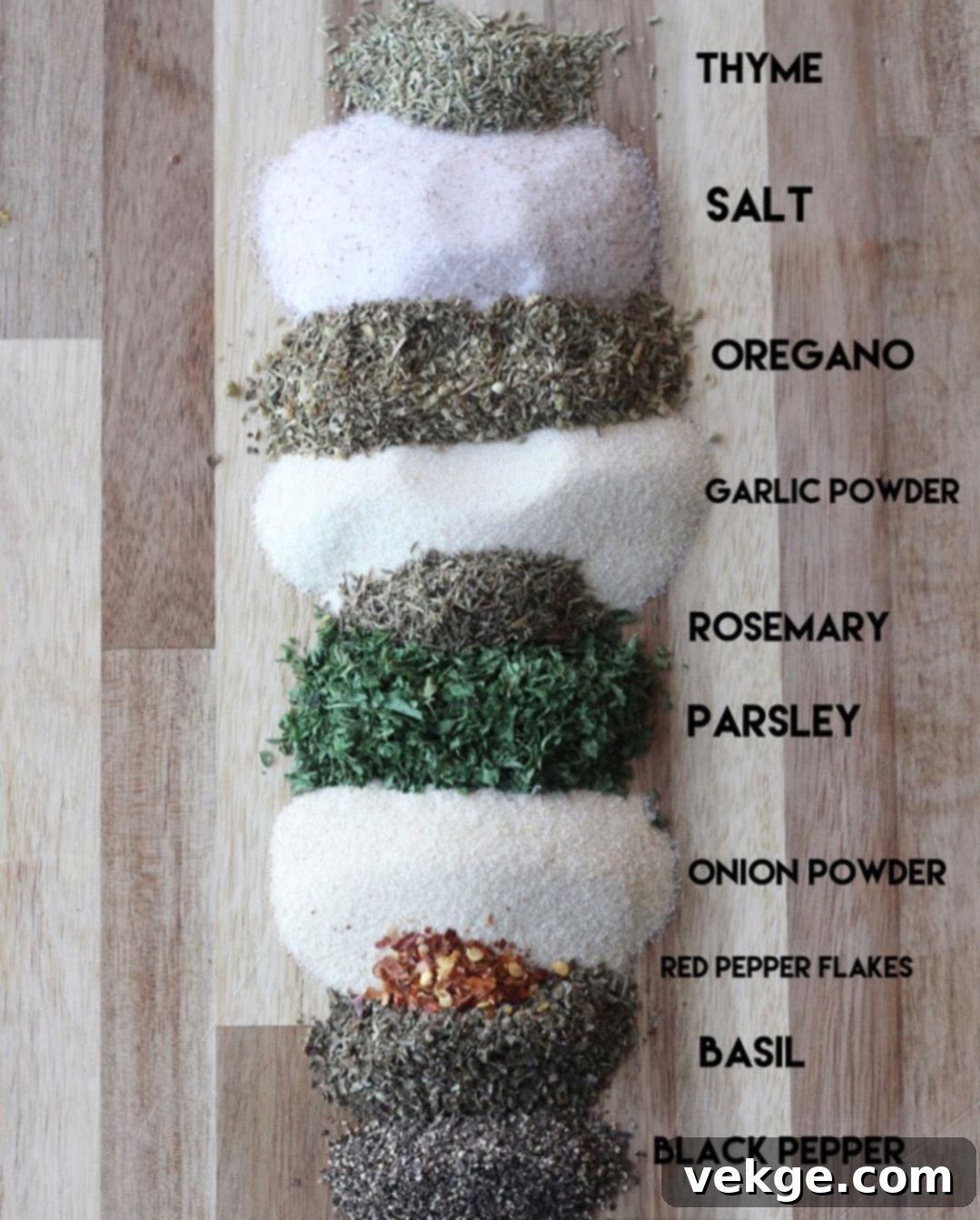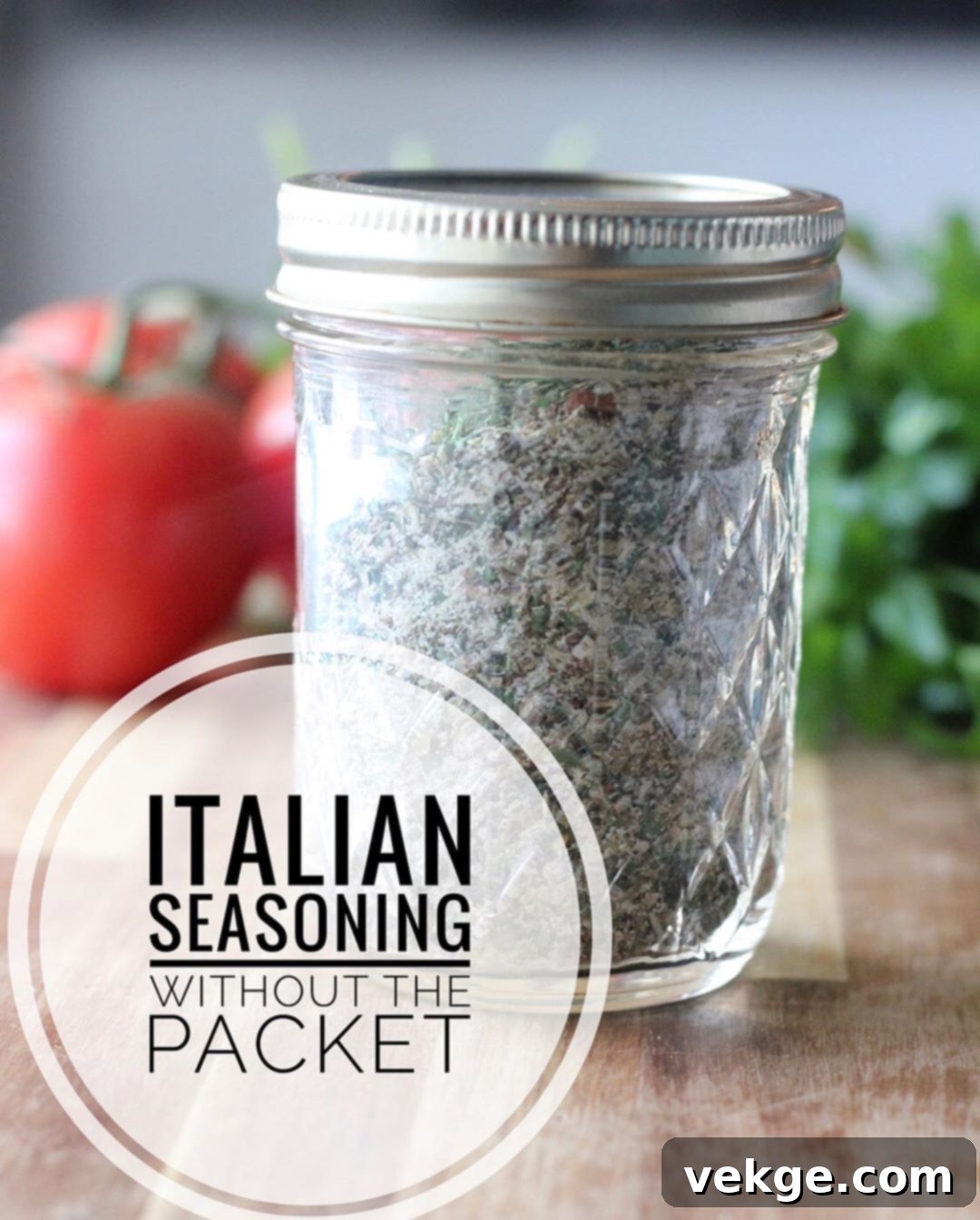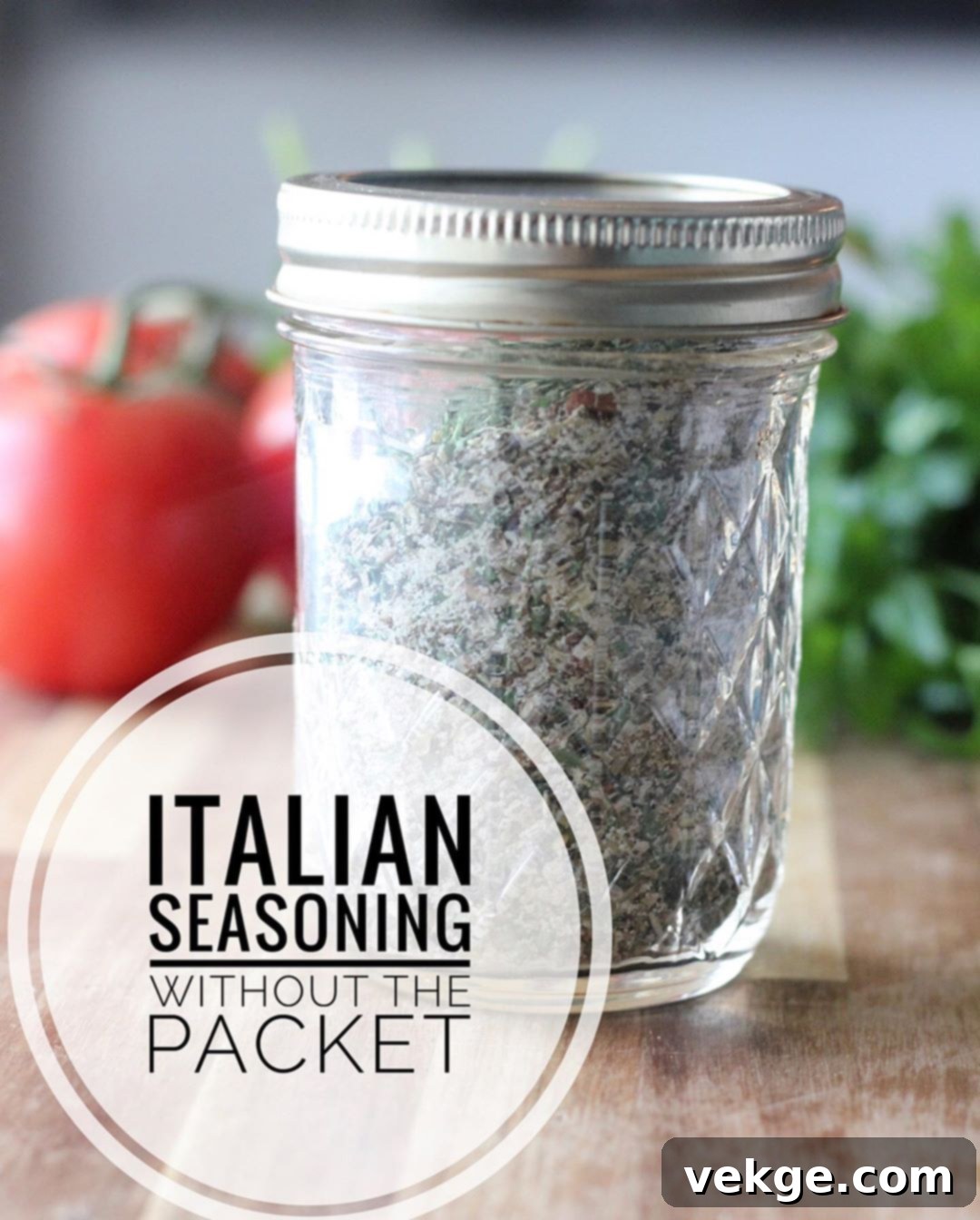Unlock Authentic Flavors: Your Ultimate Guide to Homemade Italian Seasoning
Italian cuisine holds a special place in the hearts of food lovers worldwide, celebrated for its rich, aromatic, and comforting flavors. Many of these delightful recipes, from hearty pasta sauces to succulent roasted meats and vibrant vegetable dishes, often call for a packet of Italian seasoning mix. However, a quick glance at the ingredient list on some store-bought packets can reveal an array of unexpected and frankly, unnecessary additives. Think anti-caking agents, artificial flavors, and excessive sodium – ingredients that do little to enhance your meal and can even detract from the natural goodness of your cooking.
But what if you could achieve that authentic, robust Italian flavor without compromising on purity or taste? The solution is simpler and more satisfying than you might imagine: make your own! I’m thrilled to share my go-to homemade Italian seasoning copycat recipe, and trust me, it’s nothing short of amazing. This blend isn’t just a collection of spices; it’s a culinary secret weapon that will transform your everyday cooking into something truly special. I regularly use this blend to season everything from perfectly roasted vegetables and savory shrimp to tender chicken and crispy potatoes. The depth of flavor packed into this little jar is incredible, and the best part is knowing exactly what goes into it. For your convenience, a generous 3 tablespoons of this homemade blend is equivalent to one standard store-bought packet.
Ditching the store-bought packets for a homemade alternative isn’t just about avoiding undesirable ingredients; it’s about elevating your cooking experience entirely. Freshly mixed herbs and spices bring a vibrancy and potency that pre-packaged blends, which often sit on shelves for extended periods, simply cannot match. You’ll notice an immediate difference in the aroma and taste profile of your dishes. This DIY approach also offers immense flexibility, allowing you to fine-tune the blend to your personal preferences, whether you prefer a little more garlic, a touch less salt, or an extra kick of spice. Moreover, crafting your own seasoning can be incredibly cost-effective in the long run, as buying individual dried herbs in bulk often proves more economical than continually purchasing small packets.

Why Opt for Homemade Italian Seasoning? The Benefits Are Abundant
Making your own Italian seasoning blend offers a plethora of advantages that extend beyond just avoiding questionable additives. Here’s a closer look at why this recipe deserves a permanent spot in your spice rack:
- Uncompromised Purity and Control: When you make your own seasoning, you have complete control over every single ingredient. This means no anti-caking agents, no artificial colors or flavors, and no mystery preservatives. You dictate the quality and freshness of each herb and spice, ensuring a pure and natural product.
- Superior and Consistent Flavor: The difference in flavor between freshly blended spices and pre-packaged mixes is remarkable. Dried herbs, when stored properly and used within their peak freshness, release incredibly potent aromas and tastes. This homemade blend guarantees a consistently vibrant and authentic Italian flavor profile in all your dishes.
- Cost-Effectiveness: While the initial investment in individual bulk herbs might seem higher, it quickly pays off. Over time, buying larger quantities of spices and mixing your own blends becomes significantly cheaper than purchasing countless small packets of pre-made seasoning. It’s an economical choice for any home cook.
- Customization to Your Palate: Do you adore garlic? Prefer a hint of heat? With a homemade blend, you can easily adjust the ratios to suit your taste buds. Want more oregano? Less salt? No problem! This level of customization is simply not possible with store-bought options.
- Accommodate Dietary Needs: For those with allergies, sensitivities, or specific dietary restrictions (such as low-sodium diets), homemade seasoning provides peace of mind. You can confidently ensure that your blend is gluten-free, vegan, or tailored to any other specific requirements without having to scrutinize complex labels.
- Reduced Waste: By purchasing herbs in bulk, you can often minimize packaging waste compared to repeatedly buying single-use plastic or foil packets. Store your blend in reusable glass jars for an eco-friendlier kitchen.

The Heart of Italian Flavor: A Deep Dive into Key Ingredients
Each component of this Italian seasoning blend plays a crucial role in creating its signature taste. Understanding the characteristics of each herb and spice will not only help you appreciate the blend more but also empower you to experiment and customize. Here’s a breakdown of the essential ingredients:
- Onion Powder: This provides a foundational savory depth that is subtle yet indispensable. It offers the concentrated flavor of onion without introducing any moisture, making it perfect for dry seasoning blends.
- Garlic Powder: An absolute must for any Italian blend, garlic powder delivers that pungent, aromatic, and slightly sweet flavor that is synonymous with Italian cooking. It’s an essential savory anchor.
- Salt: While often overlooked as a mere seasoning, salt is a fundamental flavor enhancer. It brightens and amplifies the taste of all the other herbs and spices, making them sing. I recommend using fine sea salt or kosher salt for an even distribution throughout the blend.
- Oregano: The undisputed king of Italian herbs, oregano contributes an earthy, slightly bitter, and peppery flavor with hints of mint. It’s a robust herb that provides the backbone of the Italian seasoning profile.
- Basil: Sweet, fragrant, and slightly peppery, basil perfectly complements the more assertive oregano. It adds a fresh, aromatic lift and a touch of sweetness that balances the overall blend beautifully.
- Thyme: This delicate herb adds a subtle earthy, woody, and slightly floral note with hints of mint and citrus. Thyme rounds out the flavor profile, adding complexity without overpowering the other ingredients.
- Rosemary: Known for its distinctive piney, woody, and slightly lemon-peppery flavor, rosemary is potent. A small amount goes a long way in this blend, adding an aromatic depth that evokes rustic Italian cooking.
- Parsley: Often used as a garnish, dried parsley adds a fresh, green, and slightly peppery note that brightens the entire seasoning blend. It contributes to the overall herbaceous quality.
- Black Pepper: A staple in virtually all savory cooking, black pepper provides a gentle pungency and warmth. Freshly ground black pepper, if you have it, can add an extra layer of aroma.
- Red Pepper Flakes (Optional): For those who appreciate a touch of heat, red pepper flakes are a fantastic addition. They introduce a subtle warmth and a gentle kick that can elevate many Italian dishes. You can easily adjust the quantity based on your preferred spice level, or omit them entirely if you prefer a milder blend.
When selecting your dried herbs and spices, aim for high-quality ingredients. Spices lose potency over time, so check their aroma – they should smell vibrant and fresh. Storing individual spices in airtight containers in a cool, dark place will help them retain their potency for longer.

Italian Seasoning Without the Packet
Print
Pin
Rate
Ingredients
- 2 T onion powder
- 2 T garlic powder
- 2 T salt
- 2 T oregano
- 2 T basil
- 1 tsp thyme
- 1 tsp rosemary
- 2 T parsley
- 2 tsp black pepper
- 1/4 tsp red pepper flakes, optional
Crafting Your Signature Blend: Simple Steps to Homemade Seasoning
Making this Italian seasoning blend couldn’t be easier. With just a few simple steps, you’ll have a jar full of vibrant, aromatic flavor ready to elevate countless meals. The prep time is minimal, but the reward is immense.
Instructions:
- Gather Your Ingredients: Ensure all your dried herbs and spices are fresh and fragrant. Stale spices will result in a less potent and flavorful blend.
- Measure Accurately: Carefully measure out each ingredient according to the recipe. Precision helps achieve the perfect balance of flavors.
- Combine and Mix: In a small bowl, whisk all the measured ingredients together thoroughly. For a finer, more uniform blend, you can pulse the mixture briefly in a spice grinder or a small food processor. This step is optional but can help meld the flavors and create a consistent texture.
- Store Properly: Transfer your freshly mixed Italian seasoning into an airtight glass jar or container. Label it with the date of preparation.
That’s it! In less than 7 minutes, you’ve created a staple that will revolutionize your kitchen. Remember, 3 tablespoons of this blend will roughly substitute one store-bought packet of Italian seasoning, but feel free to adjust to your taste in recipes.
Beyond the Basics: Versatile Uses for Your DIY Italian Seasoning
The beauty of this homemade Italian seasoning lies in its incredible versatility. Once you have a jar of this aromatic blend on hand, you’ll find yourself reaching for it constantly. It’s perfect for infusing a touch of Italian flair into a vast array of dishes, making everyday cooking more exciting and flavorful. Here are just some of the ways you can utilize your new favorite spice blend:
- Roasted Vegetables: Toss broccoli, cauliflower, zucchini, bell peppers, carrots, or asparagus with olive oil and a generous sprinkle of Italian seasoning before roasting. It caramelizes beautifully, creating an irresistible side dish.
- Meats and Seafood: This blend is a match made in heaven for poultry, pork, and seafood. Use it as a dry rub for chicken breasts, thighs, or a whole roasted chicken. Season shrimp or fish fillets before baking, grilling, or pan-searing. It’s also fantastic in meatballs, meatloaf, or as a seasoning for beef roasts and steaks.
- Pasta Dishes: Elevate your pasta sauces, from simple marinara to rich Bolognese, by incorporating a spoonful of this seasoning. It’s also wonderful in baked ziti, lasagna, or pasta salads, adding depth and authenticity.
- Pizzas and Flatbreads: Sprinkle it over your pizza dough before adding toppings, or dust it over homemade focaccia bread for an extra layer of flavor. It’s a game-changer for homemade pizza night.
- Soups and Stews: Add a pinch to minestrone, tomato soup, lentil soup, or any hearty stew for an instant boost of Italian-inspired warmth and flavor.
- Dressings and Marinades: Whisk it into your homemade vinaigrettes or use it as a base for marinades for chicken, pork, or tofu. Mix it with olive oil for a simple yet delicious bread dip.
- Breads and Dips: Transform plain bread into garlic bread by mixing the seasoning with butter. It’s also excellent stirred into cream cheese or yogurt for a flavorful dip.
- Eggs: Sprinkle a little into scrambled eggs, omelets, or frittatas for an unexpected and delightful savory twist.
- Popcorn Seasoning: For a gourmet snack, dust your freshly popped popcorn with a dash of Italian seasoning and a drizzle of olive oil.
- Homemade Sauces: From quick pan sauces to slow-cooked gravies, this blend can enhance almost any savory sauce.
Don’t be afraid to experiment! This blend is designed to be versatile and adaptable, encouraging you to bring vibrant Italian flavors to every corner of your culinary endeavors.
Optimal Storage for Lasting Freshness and Potency
To ensure your homemade Italian seasoning remains as fresh and potent as possible, proper storage is key. Following these simple guidelines will help preserve its vibrant aroma and flavor for months:
- Airtight Container: Always store your seasoning in a completely airtight container. Glass jars with tight-fitting lids are ideal as they don’t absorb odors and create a good seal.
- Cool, Dark Place: Heat, light, and humidity are the enemies of dried herbs and spices. Keep your jar in a cool, dark pantry or cabinet, away from direct sunlight, the stove, or any other heat sources.
- Avoid Moisture: Ensure your container is completely dry before adding the seasoning, and always use a dry spoon when scooping out the blend. Moisture can cause caking and diminish flavor.
- Shelf Life: While dried herbs generally last a long time, their potency gradually diminishes. For optimal flavor, aim to use your homemade Italian seasoning within 6 months to 1 year. After this period, it will still be safe to use, but the flavors might not be as vibrant. Give it a sniff – if it no longer smells fragrant, it’s time to make a new batch.
Frequently Asked Questions (FAQs) About Homemade Italian Seasoning
Q: What is the main difference between homemade and store-bought Italian seasoning?
A: The primary differences lie in the quality of ingredients, freshness, and absence of additives. Homemade blends use fresh, high-quality dried herbs and spices that you choose, ensuring superior flavor. Store-bought versions often contain anti-caking agents, excessive sodium, and sometimes artificial flavors, and the herbs may have lost significant potency due to long shelf times.
Q: Can I use fresh herbs instead of dried for this blend?
A: No, this recipe specifically calls for dried herbs and spices. Dried herbs are much more concentrated in flavor and have a different culinary application than fresh herbs. A dry blend like this needs the low moisture content of dried ingredients to prevent spoilage and allow for long-term storage.
Q: How much homemade Italian seasoning should I use in recipes?
A: As a general rule, 3 tablespoons of this homemade blend can substitute one standard store-bought packet. However, since the potency of fresh homemade blends can vary (and be stronger!), it’s always best to start with a little less than you think you need and taste as you go. You can always add more!
Q: Can I add other herbs or spices to this blend?
A: Absolutely! This recipe is a fantastic starting point. Feel free to customize it to your liking. Some popular additions include a touch of dried sage, marjoram, or even a tiny pinch of fennel seeds for a slightly different aromatic profile. Always start with small amounts when adding new ingredients and adjust to taste.
Q: Is this homemade Italian seasoning gluten-free and vegan?
A: Yes, by nature, this blend is both gluten-free and vegan, as it consists solely of dried herbs and spices. This makes it suitable for a wide range of dietary preferences and restrictions.
Q: How do I know if my dried herbs are still fresh enough?
A: The best way to check the freshness of dried herbs and spices is by their aroma. Rub a small amount between your fingers and smell it. If the aroma is strong and vibrant, it’s likely still potent. If it smells faint, dusty, or has no discernible scent, it’s probably past its prime and won’t contribute much flavor to your dishes.
Conclusion: Embrace the Flavorful Journey of Homemade Seasoning
Embarking on the journey of making your own Italian seasoning is a truly rewarding experience. It’s an act of culinary empowerment, putting you in control of the flavors that grace your dishes and ensuring that every meal is infused with the purest, most vibrant tastes. No more scrutinizing labels for unwanted ingredients or settling for lackluster flavors from stale, store-bought packets.
With this easy-to-follow recipe, you’re not just mixing spices; you’re crafting a versatile staple that will unlock new dimensions of flavor in your kitchen. From simple roasted vegetables to elaborate pasta dishes, this homemade blend promises to elevate your cooking with its authentic Italian essence. So, gather your herbs, mix up a batch, and prepare to be amazed by the delicious difference. Your taste buds, and your pantry, will thank you!
